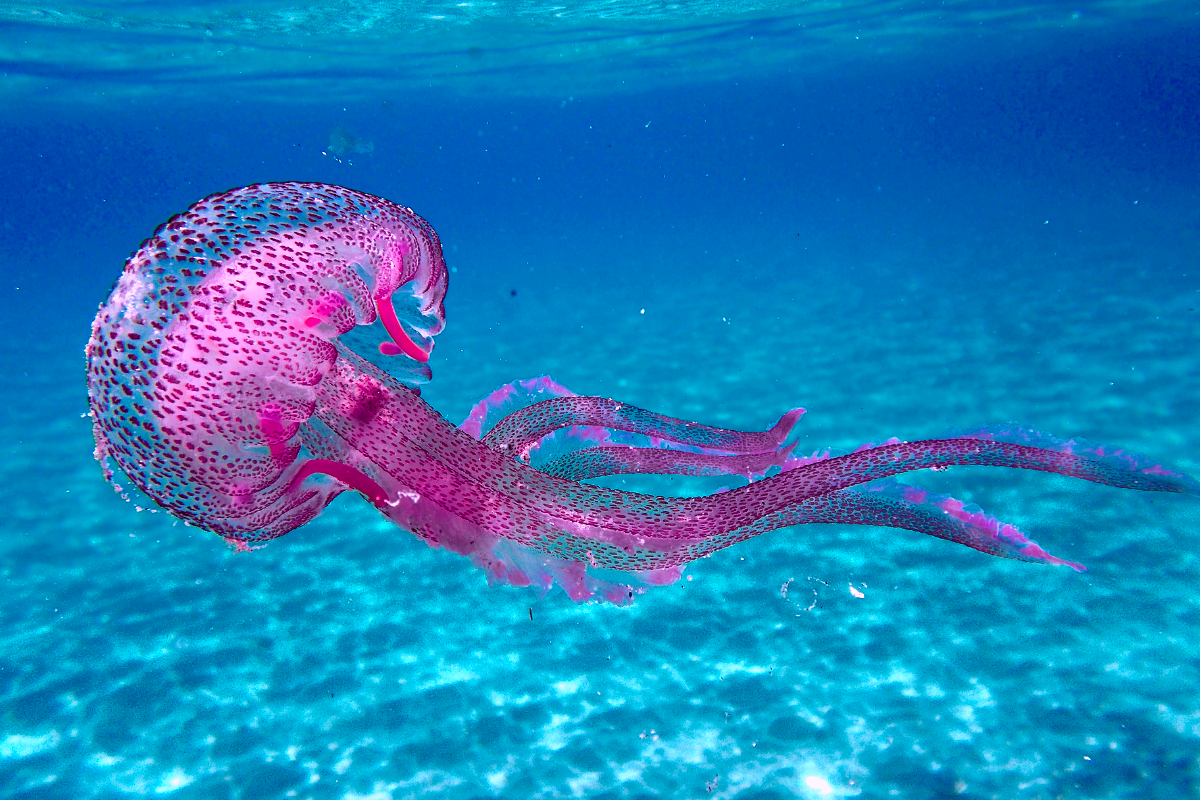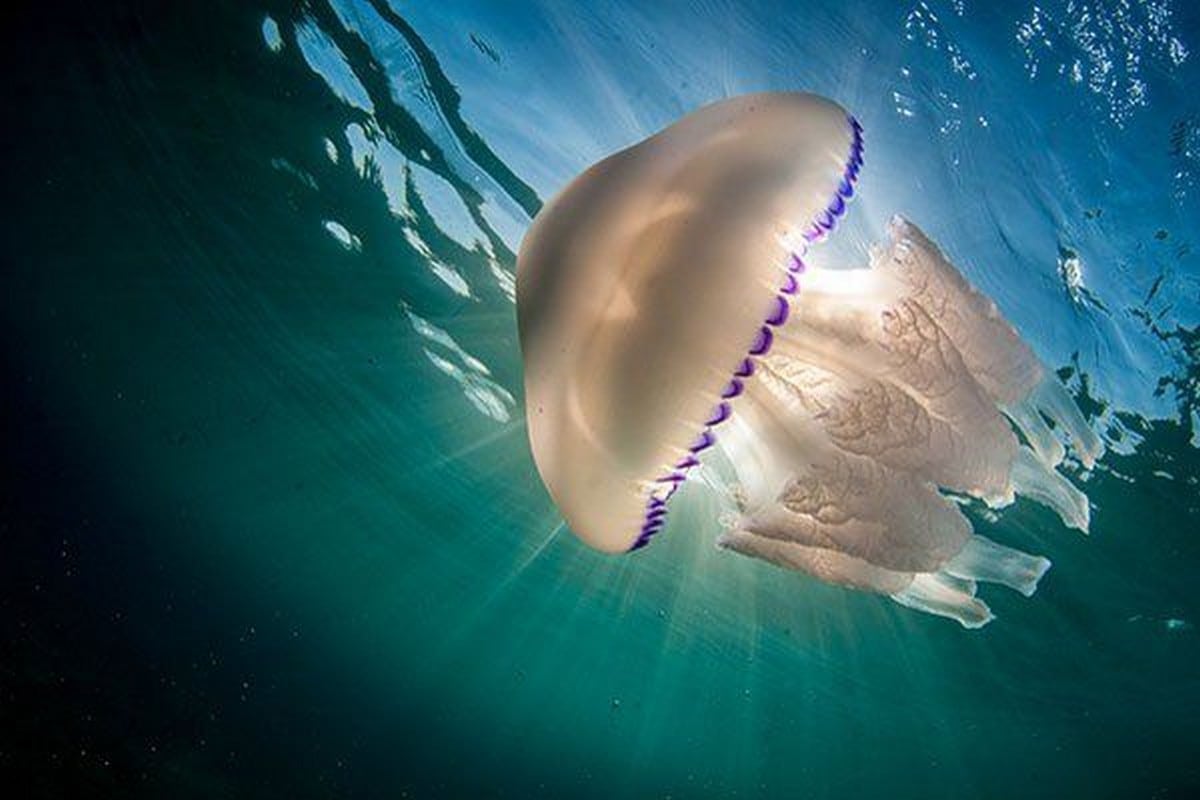Jellyfish Pelagia noctiluca: sting and treatment!

The purple jellyfish came to disturb the waters on the Greek beaches and beyond! The Pelagia phenomenon, as is known, makes its appearance from time to time, but in recent years and especially this year, it has been particularly intense in our seas.
Table of Contents
Medusa: mythology
Since ancient times, Medusa had created a world of terror and admiration around her! According to the myth “Perseus and Medusa”, there was once a beautiful mermaid, Medusa, whom Athena decided to turn into a monster with snakes instead of hair, because she desecrated her temple with Poseidon.
Her gaze was so mesmerizing that it was said that anyone who looks at the jellyfish face-to-face turns to stone. Even today, if someone encounters a jellyfish in the sea, he freezes for fear of being stung. If indeed this is a purple jellyfish, then he will be right!
Purple jellyfish: what is it?
But what exactly is the purple jellyfish and how does it differ from the others? The purple jellyfish or Pelagia noctiluca (pelagia noctiluca), as it is called scientifically, is not generally considered dangerous, however it is classified as a toxic jellyfish!
The name Pelagia comes from the Greek word “pelagos”, meaning sea, while Noctiluca combines the Latin nox (night) and lux (light), to describe its ability to glow in the dark.
It is a jellyfish/stinger measuring 6-10 cm in diameter, while its tentacles can reach a length of up to 10 meters! Its color is pink-purple (usually light) and it has vertical stripes. It has 8 simple tentacles and 4 much wider ones, while its shape is bell-shaped. It lives in warm waters and is found in various tropical places, but also in the Mediterranean. Somehow it also appeared in Greece!
Purple jellyfish: sting
A purple jellyfish sting can be quite painful, as it contains a toxin that is transferred to any organism that comes into contact with it. It is usually not dangerous, however a sensitive organism may react differently.
Since its tentacles are almost invisible in the water, we should be especially careful when swimming, as many experts claim that we can be stung even from several meters away. In addition, the tentacles are still dangerous, even if they are severed from the rest of the body.
Purple jellyfish: treatment
In general, if we are stung by a purple jellyfish we should get out of the sea immediately, so it would be best not to swim too deep.
According to many doctors and pediatricians, after getting out of the water, we should follow these steps:
- We move under shadow and ask for help
- Clean the area using a plastic card, calling card or tweezers, removing any remaining tentacles. This step must be done before pouring in seawater so that the tentacles are not transferred to another place. In addition, we also check the rest of the body, beyond the area that hurts. We can also use some stone or paper towel, but never touch with bare hands, so as not to transfer the irritation.
- Rinse the area with plenty of sea water.
- We make a mixture of baking soda and seawater, in a 1:1 ratio, and place it on the spot for a few minutes. This will relieve the pain. That’s why it would be good to always have some baking soda with us on the beach.
- Then it is good to apply some special cream or take a pill, which we will have obtained from the pharmacy, for these types of bites.
When are we going to the hospital?
There are also some alarming symptoms from a purple jellyfish sting, in which it would be good to move quickly and go to the nearest health center or hospital. These are:
- Swelling of the eyes or lips
- Shortness of breath
- Dizziness
- Hypotension
- Rashes on the rest of the body
- The person is confused
- If the bite is on the face or genitals
What not to do
It is important to remember that the sting of the purple jellyfish is different from the usual, and so is its treatment.
- As we mentioned, it’s important not to panic and touch the residue to the skin with your bare hands!
- Do not pour: fresh water, vinegar, ammonia, alcohol. Doing so will make the pain more intense, and more toxin is likely to be released.
- Do not take the jellyfish out of the sea. This will disperse the knidocytes (toxin-releasing cells), and since no one will dare go near her she will soon smell!
Other Jellyfish in Greece
-
Brown jellyfish saloufa
Also known as the fried egg jellyfish or the Mediterranean jellyfish, the brown jellyfish is thankfully harmless! If we want we can even swim next to it, as it is a jellyfish that does not sting.
The sloops, as they are called, always move on the surface of the sea, even if the waters are not shallow. Thus, they are quickly noticed.
For those who wonder what the jellyfish is and what it looks like, its size does not exceed 30 cm, it is green and brown in color and looks like a fried egg (Fried Egg Jellyfish). She also has many tiny eyes, allowing her to have 360° vision!
-
Blue jellyfish
Another jellyfish that has made its appearance recently is the azure or blue jellyfish, characterized by a purple stripe around its bell.
This is the Rhizostoma pulmo jellyfish, which is usually found in deeper water unless the winds blow it into the shallows. It can also be found in white.
Blue jellyfish are large in size, with a bell diameter of up to 90 cm, which is why they are easy to spot and avoid. They also emit toxins, which can reach us even if we swim next to them without touching them! The result is burning and itching.
However, experts say that blue jellyfish are not dangerous. If we see one approaching us, we can push it away from its bell, as long as we remember not to touch our face afterwards!
In general, jellyfish in Greek seas are not considered dangerous to our health, unless we are allergic. Dealing with a bite requires attention and especially vigilance for any symptoms that may follow.
The majority of bathers have no problem, and rarely does anyone need to go to hospital. But it is good to know the steps to deal with and above all not to panic.
So equip yourself with baking soda and just go to the beach!
Sources
Disclaimer
The content of this blogspot is not and can not be considered as medical advice, diagnosis or treatment. All information is provided to readers solely for informational purposes. There is no intention to substitute this content for personalized medical advice, diagnosis, prognosis or treatment.







Leave a comment